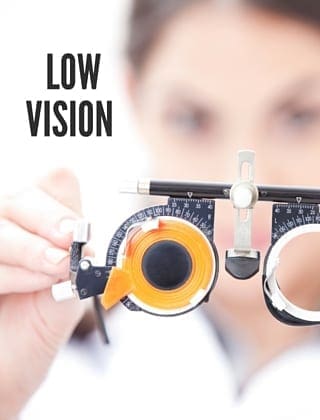We offer cutting edge Vision Rehabilitation… close to home.
LOW VISION
Our practice offers specialty services to treat those who are afflicted with sight-threatening diseases or injuries. When vision is reduced to the point where regular eyeglasses are unable to adequately allow someone to see comfortably, then we are able to prescribe low vision devices or specially engineered lenses to improve vision:
• Telescopic glasses
• Microscopic glasses
• High-power distortion-free magnifiers
• Closed-circuit televisions
• And many other electronic devices that may be used to maximize a person’s residual vision.
Along with the devices, comes rehabilitative training to effectively use these devices and to learn to use the healthy part of your eye to see better.
Some of the sight-threatening diseases that lead to low vision are:
• Macular degeneration
• Glaucoma
• Retinitis pigmentosa
• Diabetic retinopathy
• Corneal dystrophy
• Stroke/Traumatic Brain Injury
We dedicate a significant amount of time to perform a low vision examination so please be sure to discuss this when scheduling an appointment.
Learn More About Low Vision
If a family member has suffered severe visual loss, you should make an appointment for an evaluation by our low vision specialist. Low vision can result from the loss of central or peripheral vision and can exist in varying degrees. It is important to understand that visual acuity alone is not a good predictor of the problems that visual impairment can cause. Someone with relatively good acuity (e.g., 20/40) can have difficulty functioning while someone with worse acuity (e.g., 20/200) might not be having any real problems. Most individuals classified as “blind” actually have remaining sight and, thanks to developments in the field of low vision rehabilitation, can make good use of it and improve their quality of life. Treatment plans may include prescription eyeglasses, specialized optical systems, therapeutic filters, non-optical devices, and/or video magnification, and the prescription of rehabilitation therapy to effectively maximize visual functioning for activities of daily living. Therapy may also be prescribed to enhance remaining visual skills and may also include referral to other vision rehabilitation professionals, as indicated. In addition, there are numerous other products to assist those with a vision impairment, such as large-type books, magazines, and newspapers, books-on-tape, talking wristwatches, self-threading needles, and more. People with low vision can also be taught a variety of techniques to perform daily activities with what vision remains. There are also government and private programs that offer educational and vocational counseling, occupational therapy, rehabilitation training, and more. A wide variety of options are available to help people with low vision live and/or work more effectively, efficiently, and safely. Most people can be helped with one or more low vision treatment options. Unfortunately, only about 20-25 percent of those who could benefit from these treatment options have been seen by a low vision optometrist.


